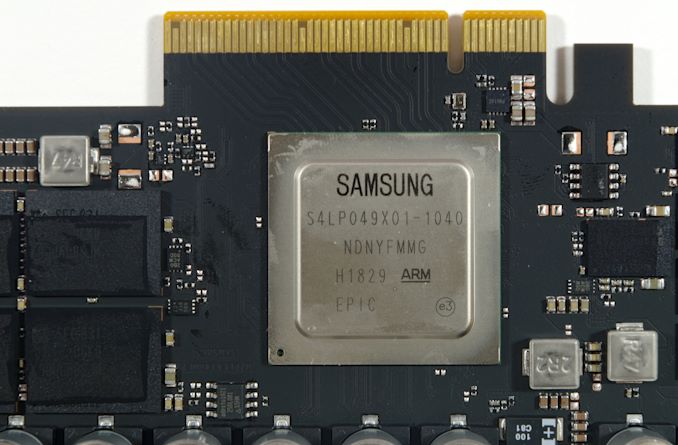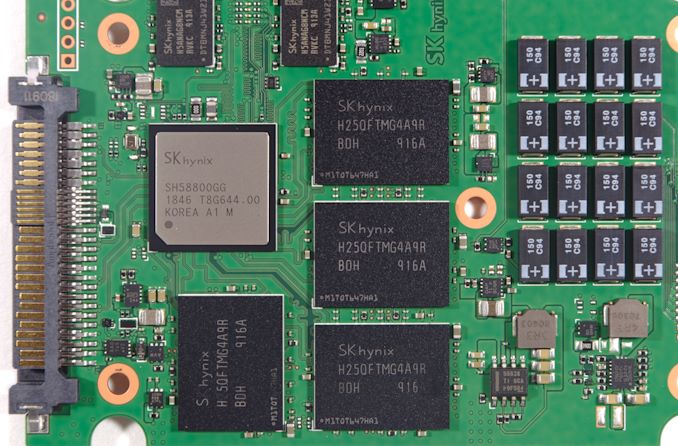Enterprise NVMe Round-Up 2: SK Hynix, Samsung, DapuStor and DERA
by Billy Tallis on February 14, 2020 11:15 AM ESTDrives In Detail: Samsung & SK hynix
Samsung PM1725a
The Samsung PM1725a is a flagship high-end model that's a few generations old. Like the Micron 5100 MAX that was in our recent SATA review, we're testing this because MyDigitalDiscount has a batch of the 6.4TB model that they're selling for just 19 cents/GB - less than many high-end consumer NVMe drives.
Despite its age, the 6.4 TB Samsung PM1725a is by several metrics the fastest SSD we have ever tested, and one of only two drives in our collection that can hit more than 1 million IOPS for 4kB random reads. The PM1725a is also rated for 5 drive writes per day, more than most current-generation high-end enterprise SSDs, and even more the successor PM1725b (3 DWPD) that replaced 48L 3D TLC with 64L TLC and slightly increased performance.
| Samsung PM1725a SSD Specifications | |||
| Form Factor | U.2 | PCIe Add-In Card | |
| Controller | Samsung S4LP049X01 "EPIC" | ||
| Form Factor | 2.5" 15mm U.2 | PCIe HHHL AIC | |
| Interface, Protocol | PCIe 3.0 x4 NVMe 1.2 |
PCIe 3.0 x8 NVMe 1.2 |
|
| Capacities | 800 GB 1.6 TB 3.2 TB 6.4 TB |
1.6 TB 3.2 TB 6.4 TB |
|
| NAND Flash | Samsung 512Gbit 48L 3D TLC | ||
| DRAM | Samsung 8Gbit DDR3-1866 | ||
| Sequential Read | 3.3 GB/s | 6.2 GB/s | |
| Sequential Write | 3.0 GB/s | 2.6 GB/s | |
| Random Read | 800k IOPS | 1000k IOPS | |
| Random Write | 160k IOPS | 180k IOPS | |
| Power Draw |
Max | 23 W | 21 W |
| Idle | 8 W | 7.5 W | |
| Write Endurance | 5 DWPD | 5 DWPD | |
| Warranty | 5 years | ||
A big part of why the PM1725a is so fast is that there's simply a lot of SSD here. The controller (labeled "EPIC") is massive, with a PCIe x8 uplink and 16 channels for interfacing with the NAND. The usable capacity is 6.4 TB, but the drive has 8 TB of flash onboard, meaning that this drive has more internal spare area than the usable capacity of the smallest SSD in this review. All these chips and the 8-lane uplink require a PCIe add-in card form factor, with a large heatsink to dissipate over 20W.
The PM1725a is a little bit outdated by only supporting version 1.2 of the NVMe spec, but it implements almost all of the optional features, including support for multiple namespaces and SR-IOV virtualization so this massive drive can be shared among several virtual machines with minimal overhead.
SK hynix PE6011
SK hynix currently holds fifth place in the overall SSD market (by drives shipped), but they're one of only three companies that is fully vertically integrated: they make their own 3D NAND, DRAM, controller, firmware and SSDs. Now that their 3D NAND seems to be catching up with the rest of the market, that vertical integration may help them significantly improve their standing in the marketplace, but they have fairly low visibility in some important market segments. They have seen the most success in the client OEM SSD market and have reentered the consumer retail market, but enterprise and datcenter SSDs are where the best profit margins can usually be found.
| SK hynix PE6000 Series NVMe SSD Specifications | |||||||
| Model | PE6011 | PE6031 | |||||
| Controller | SK hynix SH58800GG | ||||||
| Form Factor | 2.5" 7mm U.2 | ||||||
| Interface, Protocol | PCIe 3.0 x4 NVMe 1.3a | ||||||
| Capacities | 960 GB | 1.92 TB | 3.84 TB | 7.68 TB | 800 GB 1.6 TB 3.2 TB 6.4 TB |
||
| NAND Flash | SK hynix 512Gbit 72L 3D-V4 TLC | ||||||
| DRAM | SK hynix DDR4 | ||||||
| Sequential Read | 3.2 GB/s | 3.2 GB/s | |||||
| Sequential Write | 650 MB/s | 1250 MB/s | 2.3 GB/s | 2.45 GB/s | 2.45 GB/s | ||
| Random Read IOPS | 220k | 410k | 620k | 610k | 620k | ||
| Random Write IOPS | 27k | 50k | 67k | 70k | 160k | ||
| Power Draw |
Read | 8.0 W | 8.0 W | 8.5 W | 10.0 W | 10 W | |
| Write | 6.0 W | 8.0 W | 12.0 W | 14.0 W | 14 W | ||
| Idle | 3.5 W | 3.7 W | |||||
| Write Endurance | 1 DWPD | 3 DWPD | |||||
| Warranty | 5 years | ||||||
The SK hynix PE6011 and its sibling PE6031 are low-power datacenter NVMe SSDs, using the same 2.5"/7mm form factor as consumer SATA drives, but with a U.2 connector to provide a PCIe 3.0 x4 interface. Most enterprise and datacenter U.2 drives instead use a 15mm thick case to allow for stacked PCBs or more cooling and higher power levels. Using their 72-layer 3D TLC NAND, SK hynix can still pack up to 8TB of storage into this case (7.68 TB usable) along with an 8-channel controller of their own design plus the necessary power loss protection capacitors. The lower power limit of the thinner 2.5" form factor does mean the PE6011 is a bit more limited in performance than most of the drives in this review, but there are lots of other SSDs out there for this product segment that we haven't had the chance to test.
The PE6031 (not tested) is pretty much the same hardware as the PE6011, but with a higher overprovisioning ratio: more spare area, less usable capacity. That allows the PE6031 to target more write-heavy workloads with twice the random write performance and an endurance rating of 3 DWPD instead of 1 DWPD. The PE6011 targets the larger market of SSDs for read-intensive workloads.






















33 Comments
View All Comments
Billy Tallis - Friday, February 14, 2020 - link
Me, too. It's a pity that we'll probably never see the Micron X100 out in the open, but I'm hopeful about Intel Alder Stream.I do find it interesting how Optane doesn't even come close to offering the highest throughput (sequential reads or writes or random reads), but its performance varies so little with workload that it excels in all the corner cases where flash fails.
curufinwewins - Friday, February 14, 2020 - link
Absolutely. It's so completely counter to the reliance on massive parallelization and over provisioning/cache to hide the inherent weaknesses of flash that I just can't help but being excited about what is actually possible with it.extide - Friday, February 14, 2020 - link
And honestly most of those corner cases are far more important/common in real world workloads. Mixed read/write, and low QD random reads are hugely important and in those two metrics it annihilates the rest of the drives.PandaBear - Friday, February 14, 2020 - link
Throughput has alot to do with how many dies you can run in parallel, and since optane has a much lower density (therefore more expensive and lower capacity), they don't have as many dies on the same drive, and that's why peak throughput will not be similar to the monsters out there with 128-256 dies on the same drive. They make it back in other spec of course, and therefore demand a premium for that.swarm3d - Monday, February 17, 2020 - link
Sequential read/write speed is highly overrated. Random reads and writes make up the majority of a typical workload for most people, though sequential reads will benefit things like game load times and possibly video edit rendering (if processing isn't a bottleneck, which is usually is).Put another way, if sequential read/write speed was important, tape drives would probably be the dominant storage tech by now.
PandaBear - Friday, February 14, 2020 - link
Some info from the industry is that AWS is internally designing their own SSD and the 2nd generation is based off the same Zao architecture and 96 layer Kioxia NAND that DapuStor makes. For this reason it is likely that it will be a baseline benchmark for most ESSD out there (i.e. you have to be better than that or we can make it cheaper). Samsung is always going to be the powerhouse because they can afford to make a massive controller with so much more circuits that would be too expensive for others. SK Hynix's strategy is to make an expensive controller so they can make money back from the NAND. Dera and DapuStor will likely only focus in China and Africa like their Huawei pal. Micron has a bad reputation as an ESSD vendor and they ended up firing their whole Tidal System team after Sanjay joined, and Sanjay pouched a bunch of WD/SanDisk people to rebuild the whole group from ground up.eek2121 - Friday, February 14, 2020 - link
I wish higher capacity SSDs were available for consumers. Yes, there are only a small minority of us, but I would gladly purchase a high performance 16TB SSD.I suspect the m.2 form factor is imperfect for high density solid state storage, however. Between heat issues (my 2 TB 970 EVO has hit 88C in rare cases...with a heatsink. My other 960 EVO without a heatsink has gotten even hotter.) and the lack of physical space for NAND, we will likely have to come up with another solution if capacities are to go up.
Billy Tallis - Friday, February 14, 2020 - link
Going beyond M.2 for the sake of higher capacity consumer storage would only happen if it becomes significantly cheaper to make SSDs with more than 64 NAND dies, which is currently 4TB for TLC. Per-die capacity is going up slowly over time, but fast enough to keep up with consumer storage needs. In order for the consumer market to shift toward drives with way more than 64 NAND dies, we would need to see per-wafer costs drop dramatically, and that's just not going to happen.Hul8 - Saturday, February 15, 2020 - link
I think the number of consumers both interested in 6GB+ *and* able to afford them are so few, SSD manufacturers figure they can just go buy enterprise stuff.Hul8 - Saturday, February 15, 2020 - link
*6TB+, obviously... :-D